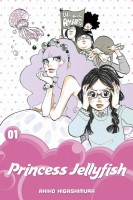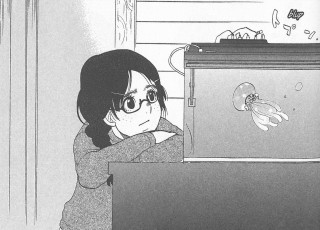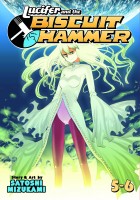 Creator: Akiko Higashimura
Creator: Akiko Higashimura
U.S. publisher: Kodansha
ISBN: 9781632362285
Released: March 2016
Original release: 2009
Awards: Kodansha Manga Award
Akiko Higashimura’s Kodansha Manga Award-winning Princess Jellyfish wasn’t a manga series that I expected would be licensed for an English-language release. Anecdotally, josei manga hasn’t historically done particularly well in the North American market. And on top of that, Princess Jellyfish is a longer series, currently ongoing at more than fifteen volumes, which can also make licensing prohibitive. When Kodansha Comics announced that it would be publishing Princess Jellyfish in print in English, fulfilling the hopes of many fans, I was thrilled. My knowledge of Princess Jellyfish stems from the 2010 anime adaptation directed by Takahiro Omori which I thoroughly enjoyed. However, as the anime only adapted a small portion of the series, it left me wanting more, so I am very excited to see the original Princess Jellyfish manga available in translation. Kodansha’s release of the series is an omnibus edition with a larger trim size and color pages included. The first omnibus, published in 2016, collects the first two volumes of the series as released in Japan in 2009.
Tsukimi is the youngest resident of Amamizukan in Tokyo, a communal apartment building catering to a particular type of woman who is completely and utterly devoted to her specific interests despite societal expectations—the fujoshi. Chieko, the manager of Amamizukan, collects traditional Japanese dolls and kimono. Mayaya is obsessed with Romance of the Three Kingdoms. Jiji has an intense appreciation for older, distinguished gentleman. Banba is fixated on trains. Mejiro is a reclusive boys’ love mangaka. And as for Tsukimi, ever since her mother took her to an aquarium as a child, she has adored jellyfish. Tsukimi’s love of jellyfish is one of her remaining ties to her mother who died of illness many years ago. It’s also that passion that leads to her chance encounter with Kuranosuke, the illegitimate son of a prominent politician who she initially assumes is a stylish and fashionable young woman due to the way he was dressed at the time. Their meeting will not only have a great impact on Tsukimi, but on everyone living at Amamizukan.
 Like the residents of Amamizukan, Kuranosuke goes against society’s set roles and expectations, but in his case he’s doing it deliberately rather than it being an unintentional side effect of an obsession. Princess Jellyfish plays with the notions of outward appearance and self-expression in some really interesting and satisfying ways. I’m generally skeptical of stories that put an emphasis on beauty and looks or that make use of dramatic makeovers (for various reasons, Tsukimi and the rest of the Amamizukan fujoshi become targets of Kuranosuke’s enthusiasm for fashion and makeup), but Princess Jellyfish is a series that recognizes that a person’s appearance is only one part of an extremely complicated whole and that attractiveness is much more than skin deep. It also recognizes that there is tremendous power in someone being able to influence other people’s perceptions of who they are and that first impressions are often rightly or wrongly based on what can be visibly seen. Kuranosuke understands this and uses that knowledge to his advantage, as does the series antagonist Inari—a woman paving the way to the demolition of Amamizukan to make way for new urban development. Through blackmail and her own sex appeal, she leverages the importance placed on appearances and society’s inherent sexist prejudices for her own benefit, often finding the circumstances to be distasteful but the feeling of being in control of them intoxicating.
Like the residents of Amamizukan, Kuranosuke goes against society’s set roles and expectations, but in his case he’s doing it deliberately rather than it being an unintentional side effect of an obsession. Princess Jellyfish plays with the notions of outward appearance and self-expression in some really interesting and satisfying ways. I’m generally skeptical of stories that put an emphasis on beauty and looks or that make use of dramatic makeovers (for various reasons, Tsukimi and the rest of the Amamizukan fujoshi become targets of Kuranosuke’s enthusiasm for fashion and makeup), but Princess Jellyfish is a series that recognizes that a person’s appearance is only one part of an extremely complicated whole and that attractiveness is much more than skin deep. It also recognizes that there is tremendous power in someone being able to influence other people’s perceptions of who they are and that first impressions are often rightly or wrongly based on what can be visibly seen. Kuranosuke understands this and uses that knowledge to his advantage, as does the series antagonist Inari—a woman paving the way to the demolition of Amamizukan to make way for new urban development. Through blackmail and her own sex appeal, she leverages the importance placed on appearances and society’s inherent sexist prejudices for her own benefit, often finding the circumstances to be distasteful but the feeling of being in control of them intoxicating.
While it is the impetus for much of the story’s forward movement in the first omnibus, the threat of losing Amamizukan is only one of many intertwined plot threads in Princess Jellyfish. Tsukimi’s maturation as she continues to deal with the pain of her mother’s death and begins to fall in love for the first time is very important to the series as is Kuranosuke’s complicated family history and relationships. Although Kuranosuke is heterosexual, considering his custom of dressing as a woman his presence in the manga brings additional elements of queerness and gender fluidity to the series which I especially enjoy. (Also worth mentioning: the Princess Jellyfish translation notes are very thorough and valuable in explaining some of the nuances of Japanese word usage and terminology in regards to various gender and queer identities, which can be quite different from their Western counterparts.) Princess Jellyfish incorporates a fair amount of comedy which is one of the reasons the manga has such charm. But while Kuronosuke’s fashion choices and gender performance can result in humorous situations, the series treats him as a person and not as a joke, which I greatly appreciate. In fact, Princess Jellyfish has an entire cast full of wonderful characters which is perhaps the series’ greatest strength.




